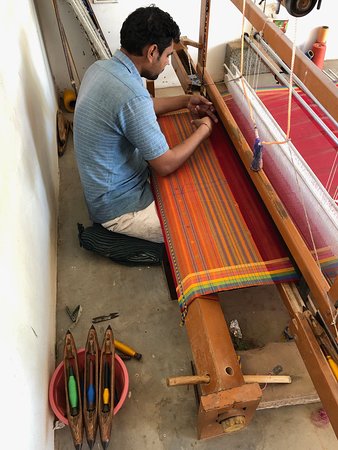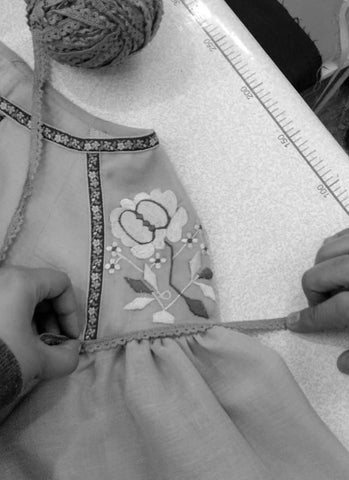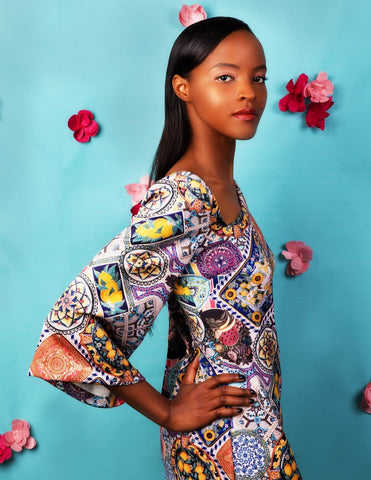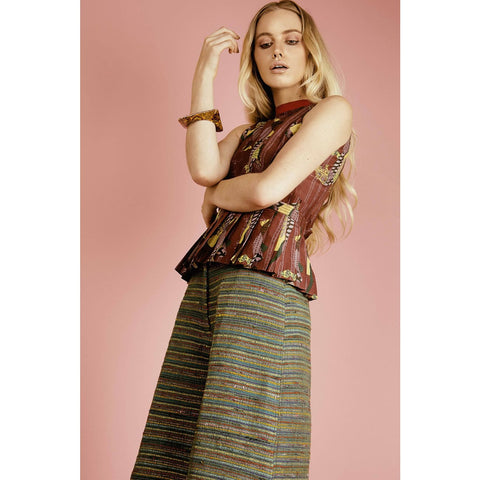
OUR SUSTAINABILITY STATEMENT

Fashion contributes over 8 percent of all greenhouse gases and, if things continue as is, by 2050 more than 25 percent of the entire global carbon budget will go to this one industry.
The carbon hotspot is at the mills (the places that spin the fiber into yarn and weave that yarn into fabric). More than 75 percent of the carbon footprint in the entire lifecycle of our clothing takes place there. To make things super clear, a company is only doing “sustainability” if they are lowering the carbon footprint of their mills. Doing this isn’t rocket science; it’s a matter of bringing in consultants to make the mills more energy efficient and changing the energy supply to renewables (and away from sources like coal). Sustainable Fashion brands like ours concentrate on working with hand woven fabrics. Many crafters in India still hand weave fabric on wooden looms. In our sustainable fashion blog you can read more about how investing in high quality pieces will go a long way in reducing negative human impact on the environment.

What is Sustainable Fashion?
According to wikipedia-
"Sustainable fashion is a movement and process of fostering change to fashion products and the fashion system towards greater ecological integrity and social justice. Sustainable fashion concerns more than addressing fashion textiles or products. It comprises addressing the whole system of fashion. This means dealing with interdependent social, cultural, ecological and financial systems. It also means considering fashion from the perspective of many stakeholders - users and producers, all living species, contemporary and future dwellers on earth. Sustainable fashion therefore belongs to, and is the responsibility of, citizens, public sector and private sector. A key example of the need for systems thinking in fashion is that the benefits of product-level initiatives, such as replacing one fiber type for a less environmentally harmful option, is eaten up by increasing volumes of fashion products. An adjacent term to sustainable fashion is eco fashion."
There are a ton of different sustainably-made fabrics, so you have options! I’m listing the most popular ones you will find amongst sustainable brands. Make sure to look for fabrics which have been dyed with eco-friendly dyes or plants.
-
Organic Cotton: According to The World Counts, we produce 29 million tons of cotton a year, which is the same as 29 t-shirts for everyone the planet. However, it is one of the dirtiest industries in the world. There are a ton of chemicals used in order to refrain from pests, and child labor is abundant. That’s why it is SO important to purchase organic cotton over conventional cotton. This ensures there are no harmful chemicals (less water, too) used to grow the fiber, and there are stricter rules for farmers to adhere to. GOTS Certified Cotton is one of the best options on the market, today. It ensures, not only a clean fabric, but an honest process from start to finish.
-
Hemp: This fiber has so much potential, and comes with many amazing properties. You don’t need any pesticides, it requires less space, it’s incredibly durable, it’s great for blending other fibers, and even the actual hemp plant absorbs more carbon than trees.
-
Organic Linen: This is one of my favorite fibers. I love the look, and it’s incredibly easy to care for. However, just like cotton or any other fibre listed here, it depends on how its grown and treated when spun into fabric.
-
Wool: Nothing can quite keep you as warm in the winter as wool can. There are a lot of ethical farmers who produce this fiber, and it can be a great way to regenerate the land. Check out FiberShed to see how they are nurturing our soil through wool.
-
Lyocell: If you love the feel of silk or bamboo, this fabric is one you should try! One of my favorite forms of Lyocell, TENCEL, is created from sustainably-harvest eucalyptus trees, and processed through a closed-loop system where solvents and water are continuously reused.
-
Micromodal: This is the only type of modal you should purchase because it is composed of pulp from sustainably-harvested beech trees. I find Tencel a better option, but it’s still one to mention on here. It’s also created in a closed-loop system like its Lyocell sister.
-
Veggie-Tanned Leather: It is so important to purchase leather which has been veggie-tanned rather the conventional tanning methods. There a ton of chemicals used when processing leather, many of which end up in waterways. Veggie-tanned does not use any chemicals, but still creates a lasting leather good.
What is "Fast fashion"
Fast fashion can be defined as disposable fashion, cheaply made clothing that is in fashion according to latest fashion trends but looses all shape after a few washes. These fast fashion clothes don't last long to justify a dignified garment life cycle and end up in trash and then in landfill. Most of these garments are made of man made fabrics like polyester (plastic) and do not biodegrade easily. One of the most apparent reasons for the current unsustainable condition of the fashion system is related to the temporal aspects of fashion; the continuous stream of new goods onto the market, or what is popularly called "fast fashion." The term has come to signify cheap, accessible and on-trend clothes, sourced through global production chains and sold through chains such as H&M, Zara, Forever21, etc. The 2012 book Overdressed: The Shockingly High Cost of Cheap Fashion by journalist Elizabeth L. Cline gives a clear introduction to the rise of disposable consumption of fashion and its impacts on the planet, the economy and consumer relationships with clothing.
However, the "fast" aspect of consumption is primarily a problem to the environment when done on a massive scale. As long as fast conspicuous consumption was reserved to the rich, the global impact was not reaching public attention or seen as a problem. That is, "fast" shopping sprees of haute couture is not seen as a problem, rather it is celebrated (for example in movies such as Pretty Woman), whereas when people with less means shop fast fashion it is seen as unethical and a problem.Today, the speed of fast fashion is common across the whole industry as exclusive fashion replicates the fast fashion chains with continuous releases of collections and product drops: the quality of a garment does not necessarily translate to a slower pace of consumption and waste.
What is "Slow fashion"
Slow fashion can be seen as an alternative approach against fast fashion, based on principles of the slow food movement. Characteristics of sustainable fashion match the philosophies of "slow fashion" in that emotional, ecological and ethical qualities are favored over uniform and bland convenience with minimal friction. It requires a changed infrastructure and a reduced through-put of goods. Categorically, slow fashion is neither business-as-usual nor just involving design classics. Nor is it production-as-usual but with long lead times. Slow fashion is a vision of the fashion sector built from a different starting point. Slow fashion is a fashion concept that reflects a perspective, which respects human living conditions, biological, cultural diversity and scarce global resources and creates unique, personalized products.
Slow fashion challenges growth fashion's obsession with mass-production and globalized style and becomes a guardian of diversity. It changes the power relations between fashion creators and consumers and forges new relationships and trust that are only possible at smaller scales. It fosters a heightened state of awareness of the design process and its impacts on resource flows, workers, communities, and ecosystems.
Slow fashion often consists of durable products, traditional production techniques or design concepts that strive to be season-less or last aesthetically and materially for longer periods of time. The impact of slowness aims to affect many points of the production chain. For workers in the textile industry in developing countries, slow fashion means higher wages. For end-users, slow fashion means that the goods are designed and manufactured with greater care and high-quality products. From an environmental point of view, it means that there is less clothing and industrial waste that are removed from use following transient trends. Emphasis is put on durability; emotionally, materially, aesthetically and/or through services that prolong the use-life of garments. New ideas and product innovations are constantly redefining slow fashion, so using a static, single definition would ignore the evolving nature of the concept.
Examples of stability of expression over long times are abundant in the history of dress, not least in ethnic or folk dress, ritual or coronation robes, clerical dress, or the uniforms of the Vatican Guard. The emphasis on slowness in branding is thus an approach that is specific for a niche in the market (such as Western-educated middle-class) that has since the 1990s become dominated by "fast" models. One of the earliest brands that gained global fame with an explicit focus on slow fashion, the UK brand People Tree, embraces the concept of ethical trade, manufactures all products in accordance with ethical commerce standards and supports local producers and craftsmen in developing countries. The People Tree brand is known as the first brand in the world that received the Ethical Trade Brand award, which was given in 2013. In addition to adopting ethical trade, the brand also prefers to use nature-friendly materials, textile products with GOTS certification and local, natural, recyclable material.
The concept of slow fashion is however not without its controversies, as the imperative of slowness is a mandate emerging from a position of privilege. To stop consuming "fast fashion" strikes against low income consumers whose only means to access trends is through cheap and accessible goods. Those who are already having a high position in society can afford to slow down and cement their status and position, while those on their way up resent being told to stay at the lower rungs of the status hierarchy. Another obstacle that the "slow fashion" paradigm is facing is related to consumers' behavior towards the consumption of fashion and specifically clothing . In fact, sustainability conscious consumers, that usually take into account social and environmental implications of their purchases, may experience an attitude-behavior gap preventing them to change their consumptions habits when it comes to choose ethical clothing. Purchasing fashion is still perceived as an action connected to social status and it is still strongly emotionally driven.
Related- Best Sustainable Fashion Bloggers
What is Ethical Fashion?
Ethical Fashion is typically in reference to the way workers are treated. Does the brand pay the manufacturer fairly? Is the farmer growing the cotton treated fairly, as well? Depending on your values, there will be different things you look for when shopping ethically. For example, if you are vegan, you would make sure the product did not contain any animal products.
It is our mission to make beautiful clothes in a beautiful Slow Fashion sustainable way. Sandhya Garg stands for style in sustainable fashion companies, and our collections are designed ethically with integrity and hand made with care, to last. We have built respectful, mutually beneficial, long-term partnerships with our factories and other suppliers, based on the highest standards of ethics and professionalism. We want to protect the environment and actively choose to work with the most energy efficient, least to zero fabric wastage and water efficient production processes available to us.

Our Pillars of Sustainability
- Small batch production- We manufacture against order, and usually do manufacturing in small batches to ensure less wastage of fabric and better craftsmanship. Each garment is worked on individually ensuring highest manufacturing quality.
- Sustainably sourced fabrics- We source our fabrics from local Indian weavers ensuring we give due respect to Indian textiles and crafts. Fabrics woven on handlooms, recycled from old sarees are also given high importance.

- Partnering with women owned factories- Most of factories we work with are women owned and employee a majority of women and heritage craftsperson. The jobs created give these women and heritage craftsperson self respect, and ability to afford a better life for themselves and their families.

- Minimal to zero waste manufacturing- We strive to reduce, recycle and reuse across all aspects of our business. Over many years, we have developed rigorous, consistent processes to monitor our partner factories and ensure they are complying with best industry practice and international standards.

- High quality, natural fibers are at the heart of Sandhya Garg collections, with silk, linen and cottons currently making more than half of our range. Sandhya Garg creates luxury garments and accessories that are designed to be treasured. We don’t chase trends. There is always an element of timelessness to our designs.
Garment use and lifespan
The environmental impact of fashion also depends on how much and how long a garment is used. Typically, a garment used daily over years has less impact than a garment used once to then be quickly discarded. Studies have shown that the washing and drying process for pair of classic jeans is responsible for almost two-thirds of the energy consumed through the whole of the jeans' life, and for underwear about 80% of total energy use comes from laundry processes. Thus, use and wear practices affect the lifecycles of garments and needs to be addressed for larger systemic impact.
However, there is a significant difference between making a product last from making a long-lasting product. The quality of the product must reflect the appropriate fit into its lifecycle. Certain garments of quality can be repaired and cultivated with emotional durability. Low-quality products that deteriorate rapidly are not as suitable to be "enchanted" with emotional bonds between user and product.
As highlighted in the research of Irene Maldini, slowing down (in the sense of keeping garments longer) does not necessarily translate into lower volumes of purchased units. Maldini's studies expose how slow fashion, in the sense of longer lasting use phase of garments, tends to indicate that garments stay in the wardrobe longer, stored or hoarded, but does not mean less resources are used in producing garments. Thus slowness comes to mean wardrobes with more lasting products, but the consumption volume and in-flow into the wardrobe/storage stays the same.

We know that our customers collect our pieces and consider them precious. Sandhya Garg pieces have multiple lives thanks to their high value on the resale market. In today’s fast fashion context, when many clothes are designed to be disposable, this is meaningful. We celebrate Indian craftsmanship, highly skilled artisanal techniques and textiles, through our unique prints, custom-designed trims and finishes. Many of our garments feature intricate embellishments and handwork that take many hours, and great heritage expertise, to produce.

These are clothes our customers invest in, and we invest in them too: with time, care and obsessive attention to detail, from the design stage right through to the finished garment. This is what we mean when talk about creating collections for durability and longevity.
- Efficient Printing of Fabrics- As a print house, we care about our water footprint and place water stewardship in high priority. In order to achieve the best possible colours and finishes, almost all of our print fabrics are digitally printed. This process uses around 60% less water than screen printing. Our suppliers use eco-friendly, low-waste techniques, and water-based dyes.


 esigner. She studied and specialized in women's fashion at London College of Fashion, UK and has worked at Alexander McQueen, Gucci, Liberty London, Alice Temperley to name a few. She has her own successful resort wear, vacation dresses, special occasion dresses, wedding guest looks, swim coverups label. While on Project Runway Season 13, she won 2 challenges and was fortunate to show her collection at Mercedes-Benz New York Fashion Week. The brand has been featured in Marie Claire US, Workshop at Macy's, Ftv.com, Elle Magazine, Cosmopolitan Magazine, Vogue online to name a few.
esigner. She studied and specialized in women's fashion at London College of Fashion, UK and has worked at Alexander McQueen, Gucci, Liberty London, Alice Temperley to name a few. She has her own successful resort wear, vacation dresses, special occasion dresses, wedding guest looks, swim coverups label. While on Project Runway Season 13, she won 2 challenges and was fortunate to show her collection at Mercedes-Benz New York Fashion Week. The brand has been featured in Marie Claire US, Workshop at Macy's, Ftv.com, Elle Magazine, Cosmopolitan Magazine, Vogue online to name a few. She designs limited edition high end printed spring dresses, casual resort attire and swim coverups. Beautiful prints are inspired from around the world to be worn during travel, resort stay or cruise holidays.

























Leave a comment